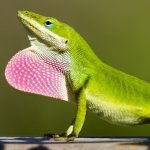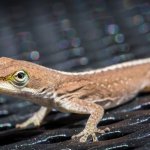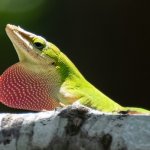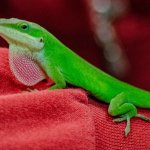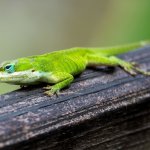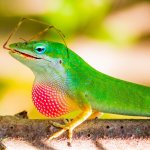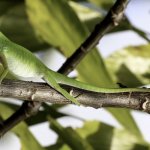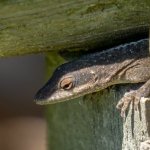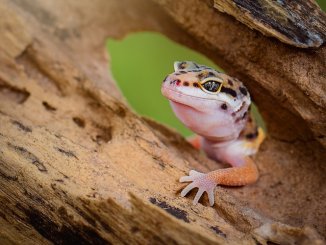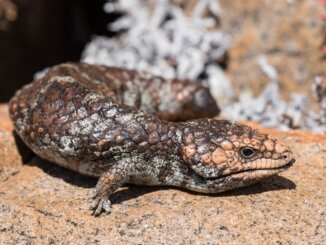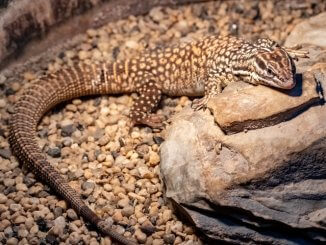The Green Anole is an active, color-changing lizard.
Green Anoles love to jump around their tank, climb glass walls and explosively jump to higher branches – they can even watch you with one eye while focusing on their prey with the other!
When these reptiles are housed in a colony, with a highly-decorated tank, they are great fun to watch.
Many people confuse this species’ cheap price for ease-of-care, but they are not a beginner reptile.
The Anole is Native to the US and is not hardy.
When stressed, they will turn brown, so this lizard needs exact humidity and lighting requirements to be kept green and healthy. Read our care guide below to learn how to keep them stress-free, green and heathy…
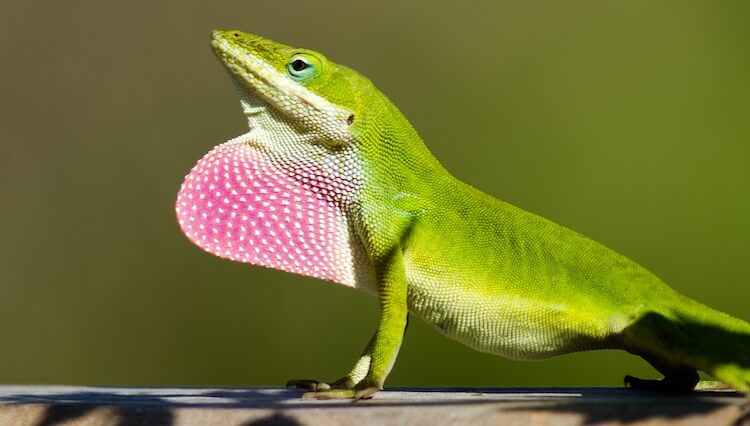
Green Anole Overview
The Green Anole is scientifically known as the Anolis carolinensis.
This lizard is from the US and can be found across the southeastern triangular region of North Carolina, Florida, and Texas.
There are several different Anolis species which have evolved by resource partitioning. This means different Anolis don’t compete over the same food and shelter-types.
The Green Anole adapted to be become completely arboreal and active during the daytime. Because of this, they feed on insects in trees or tall grass.
Other species differ in facial structure, toe-pad, toe-length, patterns, colors, and size, but all Anolis have the ability to:
- Change their color from a solid bright green to a dark brown color when stressed.
- Move their eyes independently from each other.
- Extend their dewlap (i.e. throat flap) – males only.
This lizard’s dewlap (i.e. a flap of skin that male Anoles have) can extend from their throat and is typically a reddish-pink color.
Their dewlap functions as a mode of courtship and as a way to defend their territory.
When a male Anole puffs, their dewlap and a crest on their back will become erect. This behavior, along with head bobbing, is seen as threatening towards other males – if the message is not taken, fighting will ensue.
The Green Anole hunts in a way similar to a Chameleon – they “sit-and-wait”.
Well camouflaged by their color-changing ability, this reptile uses their independently moving eyes to spot prey. They will only attack when the prey comes very close. During the attack, they secrete a venom, harmless to humans, to stun their prey.
Because of their hunting style, Green Anoles are sometimes called a New World Chameleon.
However, this is not true. They are not related to Old World Chameleons, they simply share similar hunting characteristics.
What We Like About Green Anoles
Pros
- It is possible to have multiple Green Anoles and house them in a colony.
- Because they are from the US, they are readily available.
- Many people have wild Green Anoles in their garden and benefit as they eat pest insects.
- Their solid green appearance and active nature makes them a great reptile for display tanks.
Cons
- This species is very agile and delicate, so they should not be handled regularly.
- They require advanced husbandry and need very specific tank conditions to remain healthy.
- They like to climb and escape, and so will need a very secure terrarium.
Species Appearance
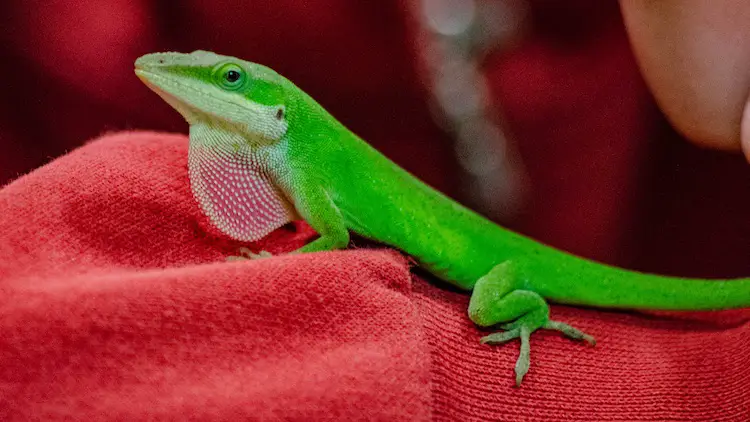
Many reptile owners love this lizard for their beautiful appearance.
The Green Anole is a slender lizard that only grows up-to eight inches in length and weighs three to seven grams – males are generally wider.
This lizard has an arrow-shaped head and thin but long-tail.
Both males and females have the ability to change their color from a bright green to a grey-brown and move their eyes independently.
Only males have a reddish-pink dewlap, dorsal crest and femoral pores.
Broad leaf eating Green Anoles have shorter hind limbs, longer fore limbs and slimmer bodies than trunk-eating Anoles.
Green Anole Habitat
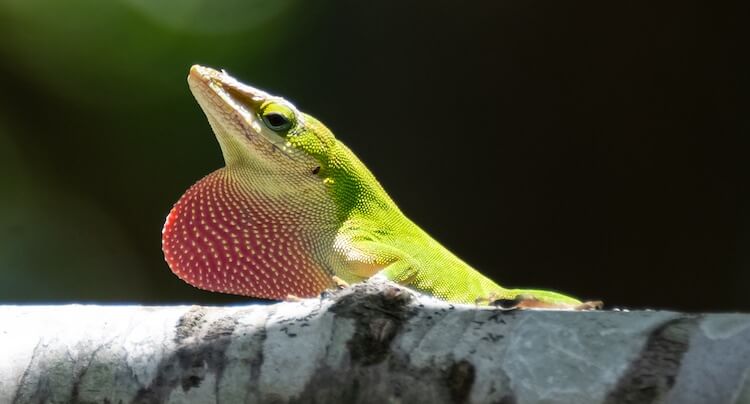
Your Green Anole’s tank must be on an elevated surface, at least five feet off the ground. They get very nervous when people or pets are hovering over them. As they naturally live high up in trees, they much prefer to be above these “threats”.
As well as placing their tank up high, to mimic their natural habitat, you should use driftwood, vines, and leafy plants in their tank.
Arrange driftwood, vines, and leafy plants to create a bioactive terrarium with basking areas by the top and shady areas underneath.
This is a lizard that requires very specific housing conditions. For new herpetologists, they can provide great learning experiences.
Green Anole Tank Size & Set Up
A tall, 10-gallon glass vivarium is best for one to two Anoles. If you want a colony of one male and three females Green Anoles then you you will need a tall, 20-gallon tank.
Their tank must be tall to account for their arboreal behavior.
A secure lid at the top of their tank is essential because this species is an avid escape artist but will not survive long outside its tank.
- Tank Type: Glass.
- Tank Size: 10 to 20 gallon tank.
- Lighting: UVA basking bulb and UVB long tube light.
- Substrate: Peat or Sphagnum moss.
The Green Anole is diurnal.
They need 12-14 hours of a basking UVA bulb and UVB long tube light each day. Aim to replace the UVB light every 6 months.
You need to create a temperature gradient within their tank.
Set the top of the tank as the “warm side” and the bottom as the “cool side.” A Green Anole’s basking area (at the top of the tank) should be 85-90ºF. The bottom of the tank’s temperature should range from 70-75ºF.
You will need to use two thermometers, one for the top of the tank, and another for the bottom.
Temperatures at night can be lower, but should not drop below 65ºF.
Use the basking blub, and an under-tank heater, to maintain heat levels. An under-tank heater can be secured to the bottom of the tank (on the outside) and should not exceed 30% of the surface area.
Never use heat rocks, they damage a lizard’s skin.
Temperature and humidity are vital for these lizards.
Use a timer for the basking and UVB lights and leave the under-tank heater on 24/7. Maintain these temperature requirements to prevent stunted growth, or illnesses such as metabolic bone disease.
The Green Anole needs humidity levels of above 50%, ideally between 60-70%. Without this level of humidity, the Green Anole will fatally dehydrate in a matter of days.
Daily misting, or an automatic misting system, will keep humidity levels high.
Include a water dish with water (purified with a dechlorinate) dripping above it. Also, place a vine leading into the dish so that if they accidentally fall in, they can easily climb out.
For suitable substrates, you have many options:
- Reptile carpet
- Peat moss or sphagnum moss with pea gravel
- Coconut fiber
- Crushed walnut shells
- Untreated potting soil with untreated leaf litter for a bioactive tank
Make sure that if you choose a loose substrate (e.g. peat moss), that it is at least 2 inches deep. Never use sand or oily wood shavings because they cause impaction and irritation.
Finally, clean the tank daily by removing waste and uneaten food.
Thoroughly clean the tank once a month by removing and replacing the substrate entirely, also wipe down the branches and vines with a phenol free cleaner.
Green Anole Care
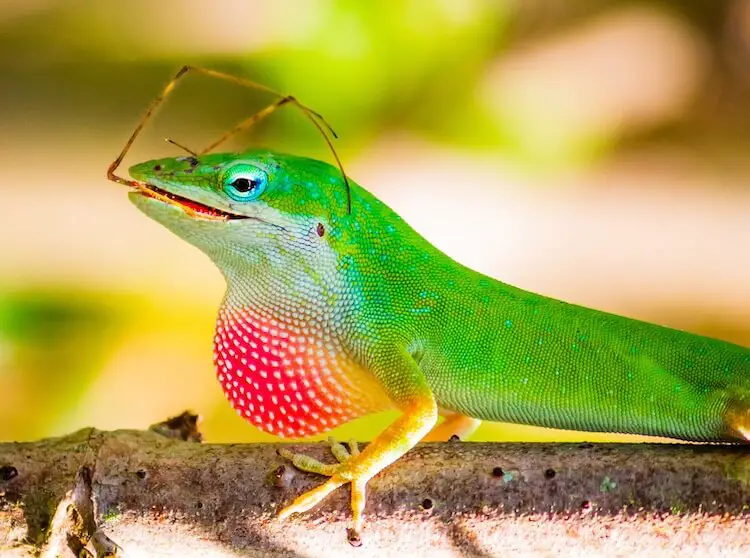
What Do Green Anoles Eat?
Anoles are insectivores – they only eat insects and worms.
Vegetation or commercial foods are not needed for this species. They only eat live prey.
You should vary their diet each day by feeding: crickets, mealworms, wingless fruit flies, and the occasional wax worm or butterworm.
Do not feed super-worms or hornworms, as their jawbones can harm this lizard.
Before serving, dust the insects with calcium and vitamin D3 powder supplements.
Feed your Green Anole as much as they will eat in 10 minutes. Typically, three to four insects per Anole is enough. The insects you feed should always be smaller than the width of your Anole’s head. Feed adults every other day and hatchlings every day.
How Long Do Green Anoles Live?
Captive Green Anoles will live anywhere from 4 – 10 years. The large discrepancy is due to the wide variations in husbandry they receive.
Many owners underestimate the correct and expensive care this species needs. They are not a beginner reptile.
If lighting, humidity, enclosure, and nutrition is correct, your Anole should live for around 10 years.
Signs They Are Healthy
- Displaying both green and brown color variations.
- Moving from basking areas to shadier spots throughout the day.
- Active, jumping and climbing in their tank.
Sickness Symptoms
- Always hiding, lethargic and not eating insects.
- Over-aggression with fellow tank mates or a dropped tail.
- A solid brown color and doesn’t return to green.
Typical Behavior
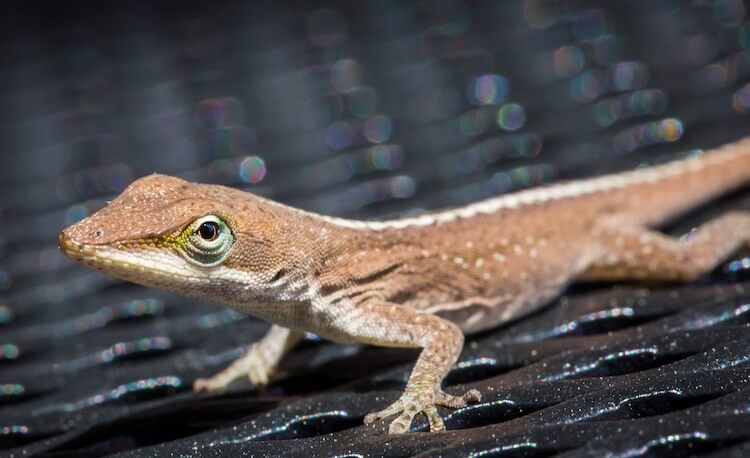
Males are very territorial, and will only allow females in.
When males encounter one another, they display their dewlaps and dorsal crests. If that is not enough, they will fight.
Green Anole males have diverged into two categories: heavyweight and lightweight. These lizards differ in testosterone levels, head-size, dewlap-size, and bite force. They also fight differently:
- Lightweights against other lightweights win by means of whoever jumps higher and runs faster because their focus is on whoever claims an area first.
- For heavyweights against other heavyweights, however, it doesn’t matter who gets there first; they win by means of whoever exerts the stronger bite force on the other.
In the wild, a Green Anole will naturally enter brumation during winter months when it becomes too cold for them to metabolize properly.
Only healthy Anoles should enter brumation in captivity.
If they are underweight or show signs of malnutrition, they will not survive,
In order to induce brumation, decrease temperatures to 65-70°F and 60°F at night. You should also decrease their light duration to only 8 hours a day and feed less food; their appetite will be gradually decreasing because of the temperature drop.
Why Does A Green Anole Turn Brown?

When a Green Anole turns brown it indicates stress, temperature-drops, or that they are not getting enough light (i.e. change in photoperiods).
If you notice they are brown, start to observe their tank behavior. If there are signs of over-aggression, separate your anole.
Appetite is also a good indicator of their wellbeing.
Not eating may indicate parasites, dehydration, or other underlying issues related to husbandry.
Green coloration tends to indicate a relaxed mood, and adequately warm temperature, with longer photoperiods.
Handling Advice and Tips
Avoid handling your Green Anole.
This species is a very delicate lizard and can be easily spooked. They will likely jump or run away from you if you attempt handling.
They will drop their tail when stressed (i.e. autotomy). Their tail will not grow back the same. Because it is no longer the same, they are unable to circulate the melanocyte-stimulating hormones to help it change color, thereby remaining brown.
If you must handle them for medical reasons, allow them to walk along your arms and shoulders.
They should never be tightly gripped. Do not make swift movements, and if they jump off, do not run after them, always approach slowly.
The best way to interact with your Green Anole is within their enclosure.
Place their daily insects in your palm, and wait patiently to hand feed them! Repeat often and always move slowly.
Be sure to wash your hands before and after feeding.
Baby Green Anole
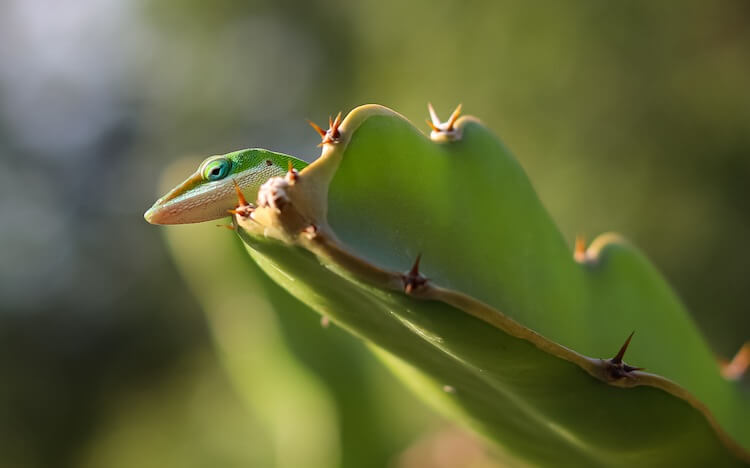
Baby Green Anoles are born just two inches in size. They are considered to be adults once they reach 5 inches in length.
They must be fed five pinhead crickets and flightless fruit flies daily.
Hatchlings can be housed in a 5 to 10-gallon tank with shredded paper towels.
Green Anole Eggs
Green Anoles will reach sexual maturity anywhere from 12-18 months.
The breeding season is from April to August, and copulation will occur anytime in the beginning half of the season. The second half is devoted to developing and laying the eggs.
Males will flaunt their dewlaps, bob their head up and down, and exert erratic, jerky movements when a female is nearby.
If a female is ready and finds the male’s courtship attractive, she will bow her head and stay still. If not, she will run away.
After fertilization, females will lay eggs every fortnight, one at a time for the next five months.
Soil, or another loose substrate, is necessary during breeding season because females will use their heads to dig a hole to lay the eggs. An under-tank heater is also essential because the substrate must measure to be 82-85°F.
Incubation lasts for one and a half months.
You can incubate in the terrarium, or take them out and incubate separately. It is recommended you incubate them separately because adults are known to cannibalize hatchlings.
Buyer’s Guide
Green Anoles cost $5 to $10 USD, however, their housing and equipment will cost around $250.
The reason this species is cheap is because of their high availability in the US and most are wild-caught. Some are bred, but they still sell for comparable prices in order to compete with the wild-caught market.
The large price difference between the Green Anole and their enclosure is the reason why many don’t receive proper care.
Green Anole Facts
| Common Name | Carolina Anole, Red-thrated Anole |
|---|---|
| Scientific Name | Anolis Carlonensis |
| Price | ~$10 |
| Size | 5 – 8 inches (males are slightly bulkier) |
| Lifespan | 4 to 10 years |
| Diet | Insects (e.g. crickets and mealworms) |
| Tank Size | 10 to 20-gallon |
| Humidity & Temperature | Humidity: 60-70% Basking temperature: 85-90°F Cool side: 70-75°F |
| Popular Alternatives | Knight Anoles, Gargoyle Geckos or Leachie Geckos |
Summary
The Green Anole is a beautiful lizard with very specific housing needs.
Experienced herpetologists will find caring for them relatively easy and ambitious beginners can care for this species providing they are interested in learning.
The Green Anole should not be handled. They are owned for their stunning appearance and active nature. Their defensive and color-changing behaviors are fascinating for many owners.
If you want a lizard that is more willing to be handled, but has similar enclosure requirements, try the Gargoyle Gecko.
Let us know below if this species will make a gorgeous showpiece in your home!

